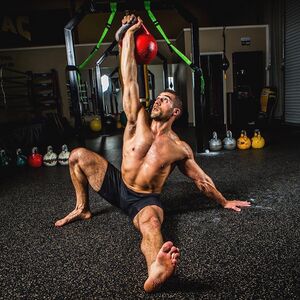Turkish Get-Up Exercise
Original Editor - SehribanOzmen
Top Contributors - Sehriban Ozmen
Introduction[edit | edit source]
The Turkish Get-Up (TGU) is a unique exercise that is used in training methodology since it promotes neuromuscular development and maintenance by achieving multi-joint and polyaxial targets of the human body [1], involves extremely precise and technical positions (such as one-arm overhead press, side crunch, side bridge, and lunge) [2] [3] and requires mobility, stability, strength, endurance and balance throughout the entire human kinetic chain [1] [4] [5].
Benefits[edit | edit source]
- Useful at training primitive motor patterns (such as rolling, and kneeling), [6] conditional and coordination skills, kinetic chains and the specificity of movements. [1]
- Builds strength by using motor skills such as co-activation and co-contraction, as well as avoiding drop-offs or loss of strength throughout the exercise. [1]
- Improves stability, mobility, endurance and muscular elasticity through the entire kinetic chains involved. [1][4]
- Useful for maintaining core stiffness since it teaches body tension and contraction strategies. [1]
- Useful for controlling spinal posture through all phases while the weight is always held overhead. [1]
- Prevents spinal pathologies by forcing athletes to learn to lock the ribcage on the pelvis while performing all exercise phases. [1]
- Supports the physical well-being concept by building motor learning processes through educational plans for growth, thus, indirectly improving athletes' psychosocial health. [1]
- Can help clinicians to identify asymmetrical movement from one side to the other, areas with less mobility, motor control or stability. By using this movement screen function, clinicians can decide if further intervention is necessary to correct movement patterns, and also mobilisation and stretching to increase mobility. [4]
Technique[edit | edit source]
The following steps indicate how to do the exercise with the kettlebell on the right-hand:
- The setup: Lye supine on the floor, grab the handle of the kettlebell with the right hand and press it straight up so it is in line with the shoulder, pack the shoulder down by squeezing the latissimus dorsii, force the grip to neutral, flex up the right hip and knee close to the right gluteal muscle, extend the left arm out to 45 degrees, laying the left palm flat on the ground.
- Braced sitting: Drive the torso up on the left elbow by using the right leg and keeping the eyes on the kettlebell, push from the left elbow to the left hand.
- Low sweep / high bridge: Transition to kneeling can be done by either elevating oneself until the left knee is off the ground little / supporting the body weight on the left arm while the right arm and hips are fully extended. Either way, the left leg is swivelled so that it is completely under the body and placed adjacent to the left hand.
- Kneeling: Move into the kneeling position so that the knee is in line with the hand and foot.
- Standing: Stand fully erect with the kettlebell overhead from the kneeling lunge position. Next, turn back to the lying position. [4]
Target Muscles[edit | edit source]
Since many muscle groups of the body work together when performing TGU, it can called a full-body exercise. It specifically recruits deltoids, rectus abdominis, external obliques, erector spinae, gluteals, quadriceps, and hamstrings. [7]
Resources[edit | edit source]
The video below is an example of how to perform the Turkish get-up exercise:
References[edit | edit source]
- ↑ 1.0 1.1 1.2 1.3 1.4 1.5 1.6 1.7 1.8 Tafuri F, Caso F, Valentino L. Training Mobility and Strength through the Turkish Get-Up.
- ↑ Ayash A, Jones MT. Kettlebell Turkish get-up: Training tool for injury prevention and performance enhancement. International Journal of Athletic Therapy and Training. 2012 Jul 1;17(4):8-13.
- ↑ Liebenson C, Shaughness G. The Turkish get-up. Journal of bodywork and movement therapies. 2011 Jan 1;15(1):125-7.
- ↑ 4.0 4.1 4.2 4.3 Shaw T. Clinical application of the Turkish Get-Up to an acute shoulder injury in a competitive Brazilian Jiu-Jitsu athlete. Journal of bodywork and movement therapies. 2019 Jul 1;23(3):628-33.
- ↑ Crawford M. Kettlebells: Powerful, effective exercise and rehabilitation tools. Journal of the American Chiropractic Association. 2011 Nov 1:7-11.
- ↑ Cook G, Burton L, Torine J. Movement: Functional movement systems: Screening, assessment and corrective strategies. (No Title). 2010 Jul 15.
- ↑ Floyd RT, Thompson CW. Manual of structural kinesiology. New York, NY: McGraw-Hill; 2009.
- ↑ Furthermore from Equinox. How to do a Turkish get-up. Available from: https://www.youtube.com/watch?v=sgd8n917Zv0







